Bullets:
AI and Robotics will create hundreds of thousands of high-paying jobs across the world over the next five years.
In the United States, trillions of dollars have been budgeted by Big Tech for new data centers, computer servers, and semiconductors.
But the industry is crashing into the inability of utilities to meet current demand for electricity, let alone to build out new sources of power supply, grid capacity, and transmission lines.
Big Tech companies are dramatically cutting back their planned projects and expansions for new data centers across the world, as regulators in the US and overseas are denying new permits for AI server farms.
High costs for electricity are running much hotter than consumer inflation, and creating deep structural problems in the economy. Households and small businesses are struggling to pay bills, and pushing for changes by lawmakers.
Report:
Good morning.
These are the 15 fastest growing careers in the world, on a percentage basis: How fast the demand for workers in these fields will grow for the next five years. Twelve of these fifteen careers are in high tech—the only exceptions are truck drivers, and environmental and clean energy engineers. Workers in all these other fields, and the companies that hire them—they need to be close to AI data centers. The fastest-growing jobs are in AI and robotics.
Our problem though is that AI and robotics need a lot of electricity to make it go. We don’t have enough electricity, and we cannot produce much more anytime soon. China has neither problem, so these jobs and the companies are moving here.
The hopes were high, and at the highest levels. Stargate is the massive, $500 billion project that was announced by President Trump in the White House, just a few days after he started work there in January.
There in the photo, from Left to Right, is the head of Softbank, the head of Oracle, and the head of OpenAI, or Chat GPT.
As soon as Stargate was announced, experts crunched the numbers and realized it was already in trouble. The Pentagon said that there isn’t enough energy in the United States to support the project. It doesn’t matter how much money there is--$100 billion now, with another $400 billion down the road. It doesn’t matter how many hundreds of thousands of American jobs are on the line. It doesn’t matter that the President wants it, along with these companies here with a jillion dollars to spend. The only thing that does matter is the bottleneck for power.
Electricity is already scarce and here the Defense Department is asking, “who should own the access to the data once it’s generated?”, and “how to manage the problem of blackouts”— which are already here. Those questions don’t have easy answers, it represents “the most underrated challenge” of all.
The Pentagon is trying to make some progress on the power generation problem. A new test site in Idaho is under construction, to build and test a new small nuclear reactor. They hope to have a demonstration test next year. This will be the first small reactor built outside of China. The Chinese are already way ahead on nuclear, and are already commercializing small nuclear reactors.
So it’s power that’s the problem. And companies and investors are already backing down from their growth plans of just a few months ago. The architects of Stargate, Softbank and OpenAI, have yet to complete a single deal. Softbank was one of the key investors who agreed back in January to spend $100 billion immediately, but now they figure they’ll be lucky if they can even get a small data center, built hopefully by the end of this year, probably in Ohio.
Softbank is unhappy at how slowly things are going. And Oracle investors probably shouldn’t be counting their chickens quite yet from their agreement with Open AI. Oracle and OpenAI signed a deal worth $30 billion a year. Doing the math on what that means, OpenAI needs to find -- or build new – the equivalent power generation for four million homes. Then, the deal itself is three times more than the company books as revenues currently.
So this is a huge gamble that ChatGPT and the other American AI systems will be affordable enough that they will attract tens of millions of paying customers for technology that free for most users now, but that the prices will be high enough that they can make enough profits for investors at Softbank to be happy. And none of that will happen unless vast volumes of new power sources can be built and turned on.
That is the urgent concern now. There isn’t any new electricity coming, anywhere. Ireland threw open their doors to the data center industry a few years ago, and now the data centers there burn more electricity than all the urban housing in the whole country. Companies like Amazon, Google, Facebook, Microsoft and TikTok use 21% of Ireland’s electricity, and now there’s not enough to keep the lights on for everyone else. Ireland’s regulators shut down new data center construction for the next three years. Amazon had plans to open a new 300-million-euro plant in Ireland, but can’t get electricity for it so they shut the project down.
Microsoft is pulling the plug on their projects in Indonesia, the UK, Australia, and in a handful of US states. Power supply is the problem for Microsoft’s data centers too. Remember this point from this Pentagon official—the power demand problem is really tricky.
If in Ireland, regulators are worried about rolling blackouts —power cut off to homes, restaurants, stores, schools, hospitals, while it is still flowing for Google and Facebook -- that will become a political problem, fast. Soon, national elections in Ireland will be won or lost based on whoever promises to flip that relationship around.
In the United States we’re looking at the same problem. The CPI is the inflation index for consumer prices, and as bad as general inflation has been since 2018, electric bills are increasing even faster. That is going to continue—electricity prices will run higher than inflation through next year, at least.
Everyone, everywhere is seeing higher bills, with double-digit increases in most of the country. But it’s especially bad on the West Coast, and on the Atlantic Seaboard from Virginia to the Canada line. For business users, it’s even worse. A pizza restaurant in New Jersey is an example—their electric bill doubled, even though their use was up just slightly. Now the Senate in New Jersey is finding out how much of an impact these data centers are having on everyone’s power bills.
About a quarter of Americans are cutting back on other necessities, food and medicine, in order to pay higher power bills. The solution to that is more supply so we can push prices down, but serious issues everywhere. Supply chain problems and shortages of everything we need to maintain the electric grid at present levels, let alone build new capacity. Prices are blowing out, and we have severe backlogs on natural gas turbines, which are needed to build new natural gas-fired power plants. Same story on transformers—we need tens of millions of new transformers just to replace the old ones, and we can’t get those either. It’s a problem across the entire grid. The grid expense is rising and nobody knows what the answer is.
We also are seeing a crunch in transmission of high-voltage power. In the United States, about 2,000 miles per year of high-voltage transmission about a decade ago, then it dropped to just 700 miles a year. And in 2023, only 55 miles of transmission. Recently a new project of 800 miles was canceled.
So not much is getting built, new demand is rising fast, and electric utilities are raising prices. Nationwide they have requested over $18 billion in rate increases, most of which will hit markets this year.
The system is already under heavy strain. A total of 2,600 gigawatts of electricity are planned across new projects, awaiting permitting and build. But that is more than twice what the United States produces now. These are projects that first need the supply chains fixed, nuclear reactors built, natural gas turbines manufactured and installed, and the electric grid upgraded. New supply won’t come for years, but the power demands for AI are hitting right now, and will double by 2030. Just keeping up with that means we need to more than triple the capacity of transformers.
We have major challenges, by everyone everywhere. The problems faced by researchers racing to build nuclear reactors like the Pentagon, by grid managers like in Ireland, by tech companies like Amazon, by investment funds like Softbank, and by pizzerias like the one in New Jersey, and by politicians who are being yelled at because there isn’t enough electricity to go around, and no more on the way.
In China, though, these problems don’t exist. Electricity production is booming. Electricity prices in China are falling, not rising. There are no order backlogs for hardware for the power grids. Industry analysts believe that the cost of AI will eventually converge to the cost of electricity. Before that, though, they need electricity. That means that these entire industries—Big Data, Fintech, Machine Learning, Data Warehousing, IOT—these AI and robotics industries will be in China. And it won’t cost very much.
Resources and links:
Reddit, r/economy, Growth in electricity generation China vs US
https://www.reddit.com/r/economy/comments/1bz7b02/growth_in_electricity_generation_over_the_last_25/
World’s first commercial mini nuclear reactor ready to power 526,000 homes in China
https://interestingengineering.com/energy/china-mini-nuclear-reactor-power-homes
Bloomberg, Microsoft Pulls Back on Data Centers From Chicago to Jakarta
https://www.bloomberg.com/news/articles/2025-04-03/microsoft-pulls-back-on-data-centers-from-chicago-to-jakarta
Defense News, Power generation challenges could overshadow Stargate AI initiative
https://www.defensenews.com/pentagon/2025/01/24/power-generation-challenges-could-overshadow-stargate-ai-initiative/
Wall Street Journal, SoftBank and OpenAI’s $500 Billion AI Project Struggles to Get Off Ground
https://www.wsj.com/tech/ai/softbank-openai-a3dc57b4
Bloomberg, Amazon Scraps €300 Million New Irish Plant in Blow to State
https://www.bloomberg.com/news/articles/2025-07-25/amazon-scraps-new-irish-plant-on-energy-issues-irish-times-says
AP, Ireland embraced data centers that the AI boom needs. Now they’re consuming too much of its energy
https://apnews.com/article/ai-data-centers-ireland-6c0d63cbda3df740cd9bf2829ad62058
NJ law to study data centers' impacts on electricity grid advances
Open AI's massive Project Stargate is already struggling, may be scaled back
https://www.techradar.com/pro/open-ais-project-stargate-is-already-struggling-may-be-scaled-back
A transformer supply crisis bottlenecks energy projects
https://spectrum.ieee.org/transformer-shortage
PowerLines, Utility bills are rising
https://powerlines.org/wp-content/uploads/2025/04/PowerLines_Utility-Bills-Are-Rising_2025-1.pdf
Vox, Why your energy bill is suddenly so much more expensive
https://www.vox.com/climate/420887/electricity-energy-bill-expensive-prices-rising
Why is my electric bill so high? New Jerseyans point fingers but what is being done?
https://www.northjersey.com/story/news/new-jersey/2025/07/24/why-is-my-electric-bill-so-high-what-to-know-about-rising-nj-rates/85330762007/
EIA, U.S. electricity prices continue steady increase
https://www.eia.gov/todayinenergy/detail.php?id=65284
MIT, Confronting the AI/energy conundrum
https://climate.mit.edu/posts/confronting-aienergy-conundrum
Charted: The World’s Fastest Growing Jobs (2025-2030)
https://www.visualcapitalist.com/charted-the-worlds-fastest-growing-jobs-2025-2030/


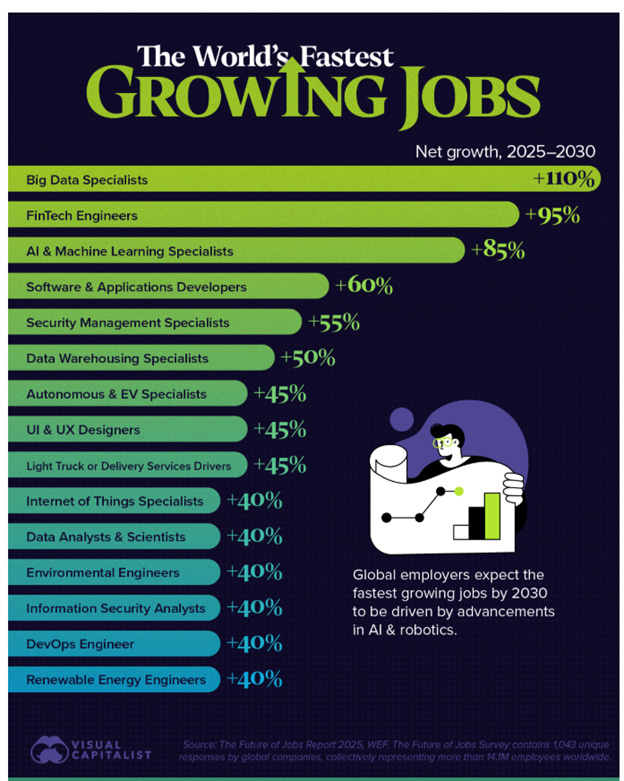
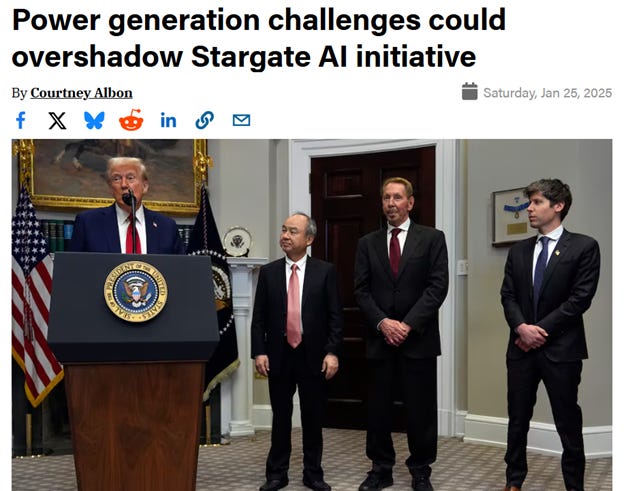
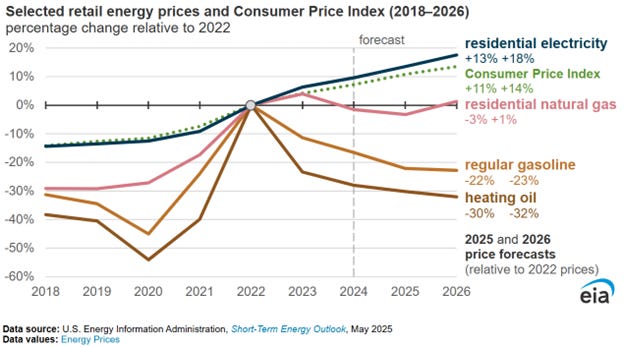
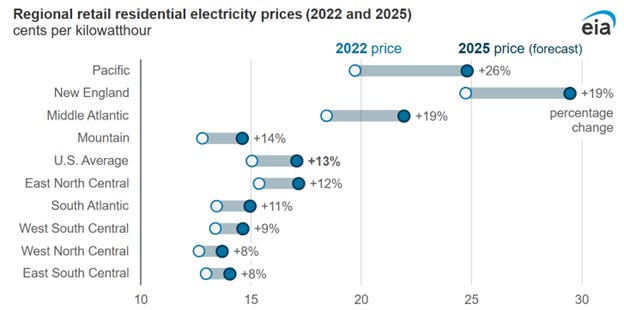
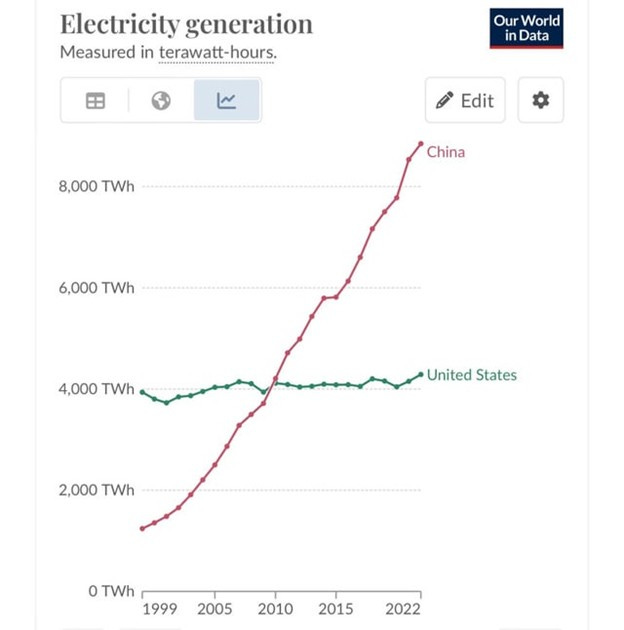
I concur, great work. Anyone with any sense in economics could have seen this coming. Even their own AI models would have told them had they listened. The TACO regimes cuts off wind and solar, and expects to ramp up AI doesn’t pass muster.
This is great work. Thank you.